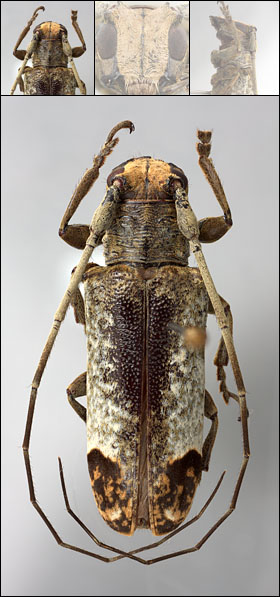 |
 Previous Genus Next Genus Previous Genus Next Genus 
Genus: Apocoptoma
Diagnostic Features
- Description: Elongate-oblong, robust, moderate to large-sized, ranging from about 15–23 mm in length. Integument generally dark brown with whitish and ochraceous pubescence.
 Head with frons subquadrate to slightly elongate, about as wide as width of two lower eye lobes. Eyes with lower lobes moderately large in size, oblong. Genae variable in shape, from slightly transverse to slightly elongate, shorter than lower eye lobes. Antennal tubercles prominent, widely separated; tubercles armed at apex with small projection (females) or with a moderate-sized, rounded process (males); antennae slightly longer than body (females) to more than twice as long as overall body length (males); scape clavate, shorter than antennomere IV; antennomere III nearly straight to slightly curved, distinctly longer than scape and IV; antennomere XI about as long as X (females) or about twice as long as X (males); antennomere distinctly long in males, about 2/3 as long as elytra. Pronotum transverse, roughly cylindrical, without lateral tubercles; pronotal disk transversely rugose. Elytra with sides nearly straight; elytral apices individually rounded; elytral apices with distinct maculae of darker color; base of elytra with two prominent tubercles at humeri. Basal 1/3 of elytra with dense punctation, surface coarsely punctate or granulate-punctate. Procoxae without projection (females) or with small acute projection or distinct curved hook (males). Mesosternal process with apex feebly to deeply emarginate. Metafemora distinctly short, about 1/4–1/5 as long as elytra. Head with frons subquadrate to slightly elongate, about as wide as width of two lower eye lobes. Eyes with lower lobes moderately large in size, oblong. Genae variable in shape, from slightly transverse to slightly elongate, shorter than lower eye lobes. Antennal tubercles prominent, widely separated; tubercles armed at apex with small projection (females) or with a moderate-sized, rounded process (males); antennae slightly longer than body (females) to more than twice as long as overall body length (males); scape clavate, shorter than antennomere IV; antennomere III nearly straight to slightly curved, distinctly longer than scape and IV; antennomere XI about as long as X (females) or about twice as long as X (males); antennomere distinctly long in males, about 2/3 as long as elytra. Pronotum transverse, roughly cylindrical, without lateral tubercles; pronotal disk transversely rugose. Elytra with sides nearly straight; elytral apices individually rounded; elytral apices with distinct maculae of darker color; base of elytra with two prominent tubercles at humeri. Basal 1/3 of elytra with dense punctation, surface coarsely punctate or granulate-punctate. Procoxae without projection (females) or with small acute projection or distinct curved hook (males). Mesosternal process with apex feebly to deeply emarginate. Metafemora distinctly short, about 1/4–1/5 as long as elytra.
- The combination of the following characters will help to distinguish this genus: moderately large eyes; roughly cylindrical pronotum; elytra with sides nearly parallel; and distinctly short metafemora.
- Similar genus/genera: superficially resembles Chitron, Leus, and Trestonia.
Geographic Distribution
Host Plants/Trees
Girdling Behavior
Notes
Generic Synonymies
Selected References
|
 |
 
Apocoptoma chabrillacii
♀ specimen
© E.H. Nearns
|
© 2011-2015 Nearns, E.H., Lord, N.P., and K.B. Miller
The University of New Mexico and Center for Plant Health Science and Technology, USDA, APHIS, PPQ.
|


